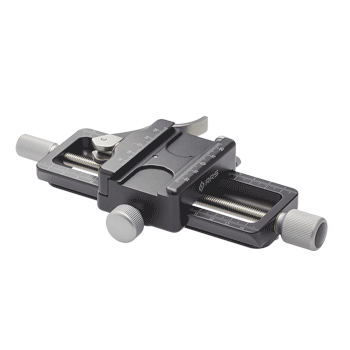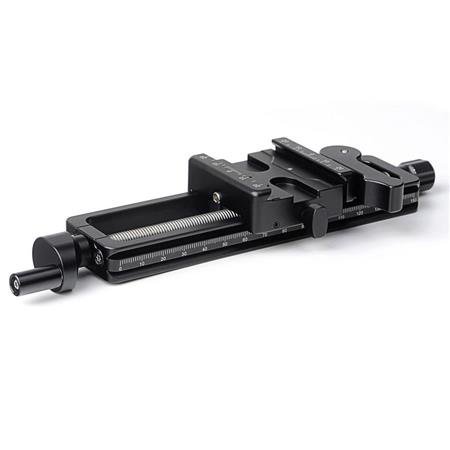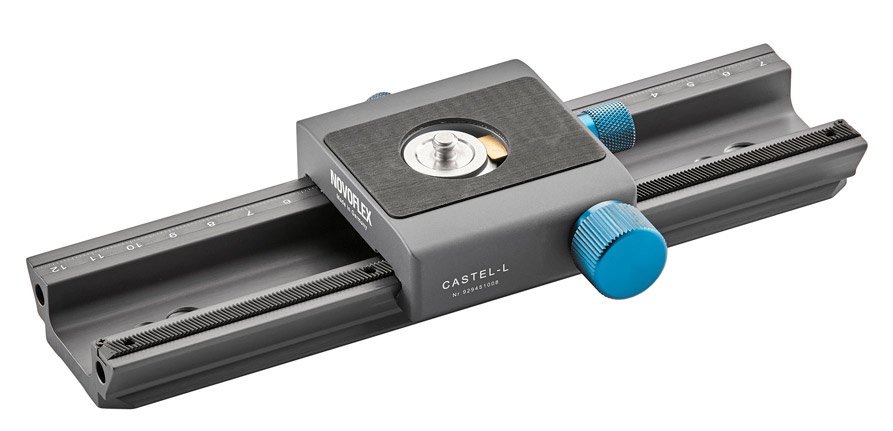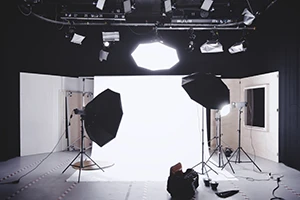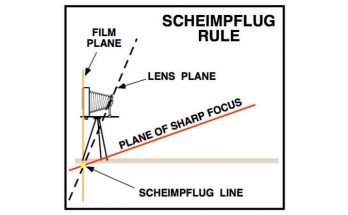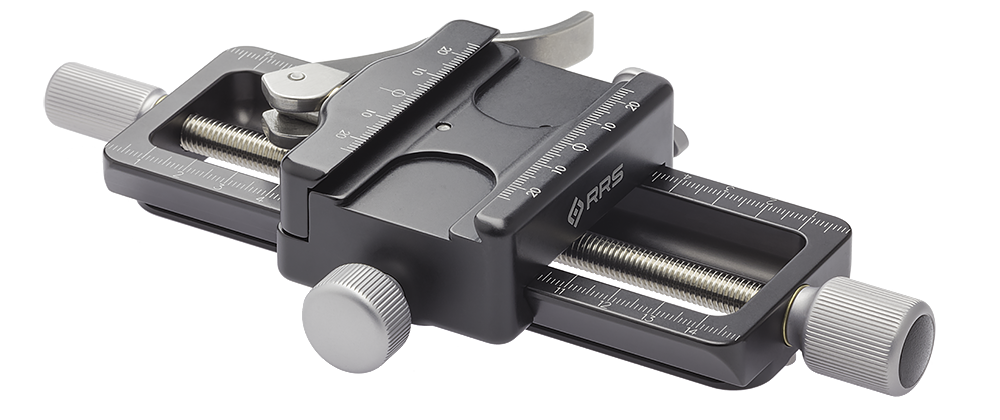
What is a macro focusing rail and how does it work?
A macro focusing rail, also referred to as a macro slider or a focusing rack, is a device used to precisely control the camera position during high-magnification photography work. The typical geared macro slider is a device comprising of a fixed track or base and a movable platform that is moved along the track using the gear knob. Gear mechanisms in macro focusing rails are either rack and pinion or lead-screw types. This construction allows for precise measured movement while retaining the necessary stability of the rig.
As its name implies, a macro focusing slider is predominantly used in high-magnification imaging, for example in scientific or product photography. Some photography techniques, like focus stacking in particular, benefit greatly from the control these devices deliver.
They can be successfully used in video too, especially when shooting close ups, making stop motion animation or timelapse sequences. A focusing rail can not, however, replace a dedicated video slider, as it is not designed to provide the same type of movement.
In addition to focusing and composition, a rack can also be used as a balancing device for heavy rigs, or as way to position the nodal point in panoramic photography. You can learn more about the alternative uses of these devices in our dedicated section below.
How do you use a macro slider?
A macro slider goes between the camera and the tripod / tripod head. The majority of macro photography sliders are made to accept standard 1/4″ camera mounting screws which enables the use of many additional accessories such as quick release plates, L-brackets, risers and others. A macro focusing slider is often used in conjunction with other related equipment like macro bellows, reverse rings, extension tubes or geared tripod heads. There are two typical ways in which a macro rail is used.
Focus
The most common use of a focus rail is to move the camera closer or further from the object to fascilitate precise focus control in macro photography. Due to the optical specifics of high-magnification photography, focusing by changing the distance between lens and object is usually more convenient and effective than using the lens’ focus ring. What’s more, many specialist macro lens setups do not have focusing mechanisms at all, which makes a slider essential.
Because of the limited depth of field in macro shooting, photographers often have to resort to focus manipulation techniques, especially focus stacking. A macro rail is an essential accessory for such work.
Composition
The other way to employ a focus rail is to rig the camera sideways, so that the lens points perpendicular to the rail. This setup is used to aid in composition, because many tripod heads may prove to be inaccurate at the high magnifications used in macro photography. The side-to-side movement can also be used when an object is too large to fit in a single shot at the desired magnification. The controlled sideways movement allows for precisely composed overlapped images to be shot and easily stitched in post.
Special 4-way cross rails enable both movements to be controlled simultaneously, alowing for much greater flexibility. See more about the different focusing rail models in the dedicated chapter below.
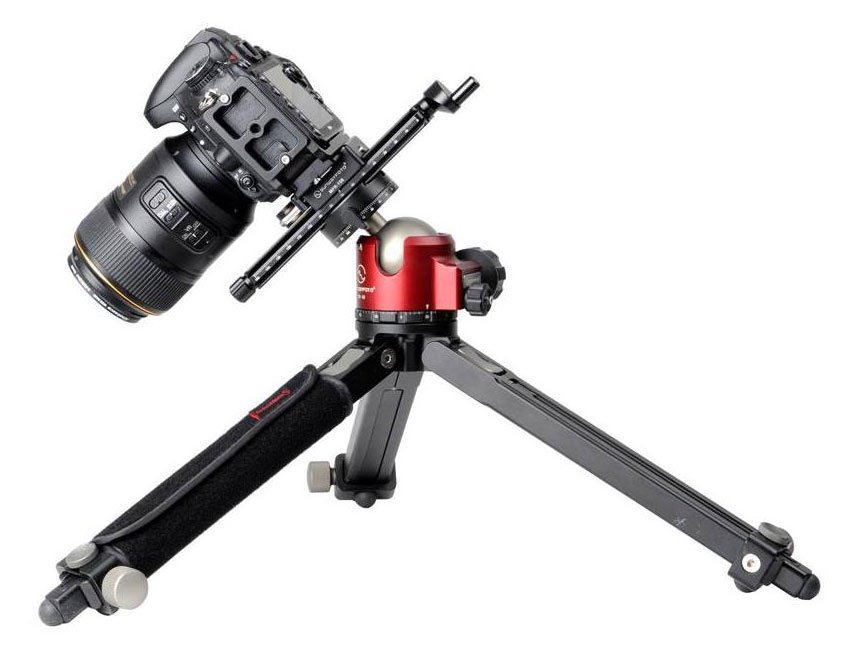
Alternative uses of a macro focusing slider
In addition to their main function as focusing devices for high-magnification photography, these racks can be used in many other configurations. The ability to easily position a camera with micrometric precision comes handy in a number of photographic tasks.
Panoramic photography
One such application is in stitched panoramic photography. You can read all the specifics in our panoramic photography guide, but here is the short version. The process consists of taking multiple overlapping pictures from the same position and then stitching them all in software. This way, you can achieve greater resolution and/or field of view.
A key requirement of panoramic photography is to rotate the camera on it’s nodal point axis. This point is different for any camera-lens combination, so it’s important to have a way of adjusting the position on the camera on top of the tripod head easily and securely. This is where a focusing rack comes in handy.
Focusing racks as balancing plates
Sometimes in photographic practice, we find ourselves using elaborate camera rigs with large lenses, flashes, shades and other accessories. More often than not, such a rig would be quite off-balance using the default camera mounting point to attach it to a tripod head. Correctly balancing the camera rig on the head greatly improves handling and ease of use. In video shooting and precision photographic work proper balance is absolutely crucial to control.
Cine camera systems achieve this using bridge plates riding on dovetail plates. Not having to fight the camera every time you unlock the tilt movement will save you a lot of time and nerves. A geared tripod head mitigates some of these inconveniances but is no substitute for a balanced rig. In addition, a heavy off-balance camera puts undue stress on the gear mechanisms.
This is one of the reasons why large telephoto lenses have their own collar tripod mounts. Virtually all fluid video tripod heads have some sort of balancing mechanism. However, if we are not using such a lens or head, or we still can not achieve correct balance using these devices, then we need a way to shift the mounting point to the point of balance. A popular way of doing this is using the Arca Swiss quick release plate system, which provides plates of varying length to facilitate proper balance and support. You can read more about the different options in our quick release plate guide.
On its own, or in conjunction with the abovementioned devices, a macro focusing slider is an excellent tool to achieve correct balance of a camera rig. The gear mechanism allows for precise dialing of the necessary offset and enables quick corrections as changes are made. It is no accident that the Steadicam, a device that functions solely on balance, utilizes a variation of a focusing rack to achieve it.
What are the different macro slider types?
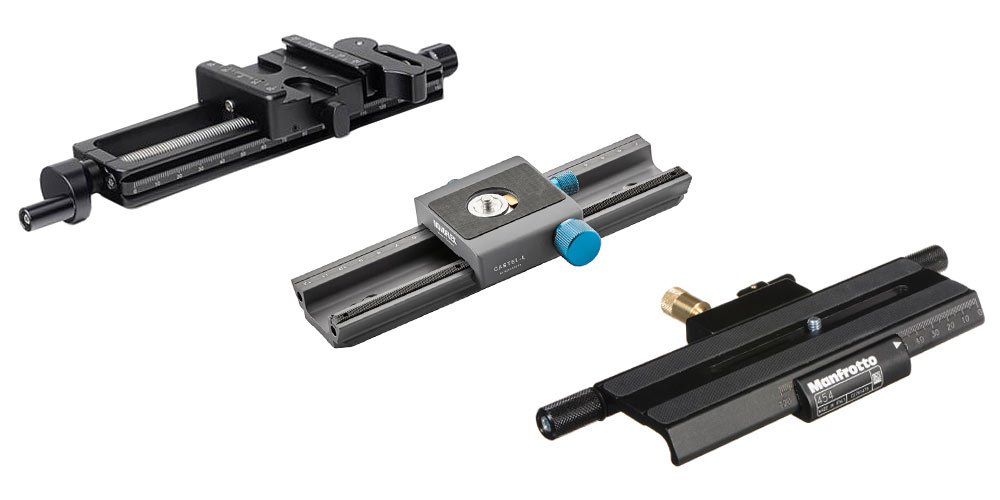
Single stage rails
Single stage rails feature only one gear movement mechanism. The simplest and most stable kind of focusing racks, they are often the basis for more complicated models. Single stage racks are also the most suitable for use as balancing plates as described in the previous chapter.
There are a couple of different macro rail mechanical designs on the market. The differences between them are most evident in the single stage models, as pictured above.
Lead screw fixed rail type
The first design is the lead screw fixed rail type, pictured here as the Sunwayfoto MFR-150S, the Manfrotto 454 Macro Focusing Rail above and the Really Right Stuff B150-B at the top of the guide. This design comprises of a fixed rail upon which a platform is moved via the lead screw mechanism. A common design approach, featured in both RRS and Sunwayfoto, is to make the bottom of the rail compatible with the Arca Swiss clamp standard. This way, the macro rail is easily attached to a variety of tripod heads and adaptors. The ability to attach the clamp along the whole length of the rail provides a lot of options for balancing and positioning.
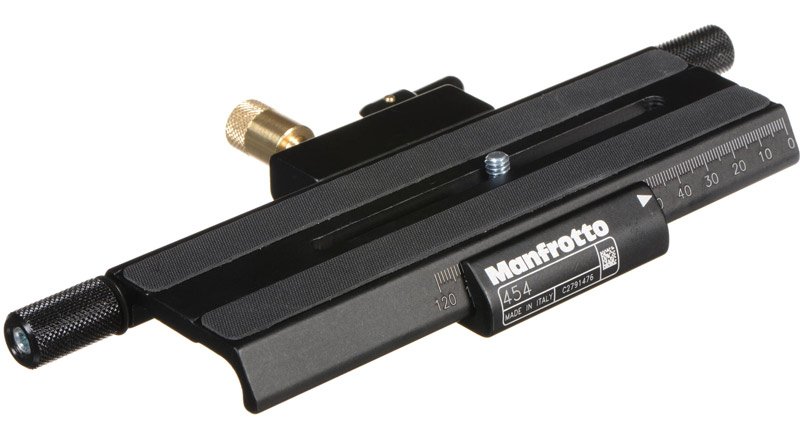
The Manfrotto 454 rail, on the other hand, utilizes a slightly different design approach. As you can see from the pictures, the driving screw is part of the larger upper slide, as opposed to being housed in the unit’s base as in the RRS and Sunwayfoto models. This leaves a small base that is attached to the tripod head. The Manfrotto 454 does not offer Arca compatibility out of the box, but it can be achieved with adaptor plates.
A benefit of this construction can be seen in the large moving platform upon which the camera is attached. When using complicated macro camera rigs that include bellows, long extension rings or flashes, the large support platform can provide increased stability and rigidity. Stability is paramount when you need to match a lot of exposures, for example when focus stacking. Compared to the RRS and Sunwayfoto, the 454 also offers a lot lower height, which can be benefitial in certain situations.
Rack and pinion fixed rail type
The rack and pinion fixed rail is arguably the most popular type of macro photography rails on the market. Instead of a lead screw, here movement is transferred from a small pinion cog meshing with a rack running the length of the rail. This type of movement is often used in field cameras and ensures high precision and stability. Care has to be taken to keep the rack clean of debry as it might jam the mechanism. In the Novoflex unit pictured above, just like in the Sunwayfoto, the bottom of the rail is compatible with the Arca Swiss clamp standard.
The main difference between the lead screw and rack and pinion rails is the way movement is achieved. Whereas in the lead screw model the knob you rotate is in a fixed position at one end of the rail, in the rack and pinion type the knob is attached to the camera platform. You might find one or the other more comfortable, depending on the type of camera you are looking to put on the rail and the shooting configuration. For example, a bulky camera might make access to the pinion knob difficult. On the other hand, a bulky lead screw knob might make placing the rig in a tight spot difficult or impossible.
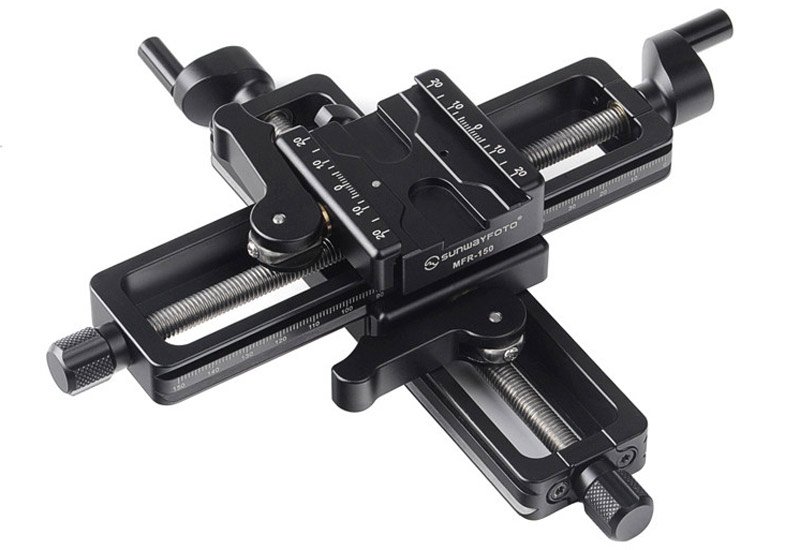
Dual stage rails
Two stage rails, also called 4 way sliders, are the second variation of this device. A dual stage macro rail allows you to move the camera in both X and Y directions, much like a microscope linear stage. While not strictly needed for tasks like focus stacking, dual rails make macro photography framing much easier and faster. The shallow depth of field and high magnification typical of such shoots render framing with traditional tripod heads rather clunky and uncomfortable.
There are two general construction approaches to dual axis macro rails:
Stacked single stage macro rails
The first and more flexible option to get 4 way movement is to stack two single stage macro rails like the pair of MFR-150 pictured above. If you already have a rail, then you can simply get a second one. Both rails do not necessarily have to be the same make or model. Having them all using the Arca Swiss standard like the Sunwayfoto above will add a bit of convenience though.
The advantages of this setup are obvious. When you do not need dual axis movement, you can dismantle both rails and use them independently. This also allows you the flexibility to sacrifice one axis in lieu of lower height, which can be crucial in certain situations. A drawback can be seen in the increased price and complexity of the setup. You are buying two separate units, and that usually will cost more than an integral 4 way slider on it’s own. On the other hand, if you already have a single stage rail, this might be a more economical option.
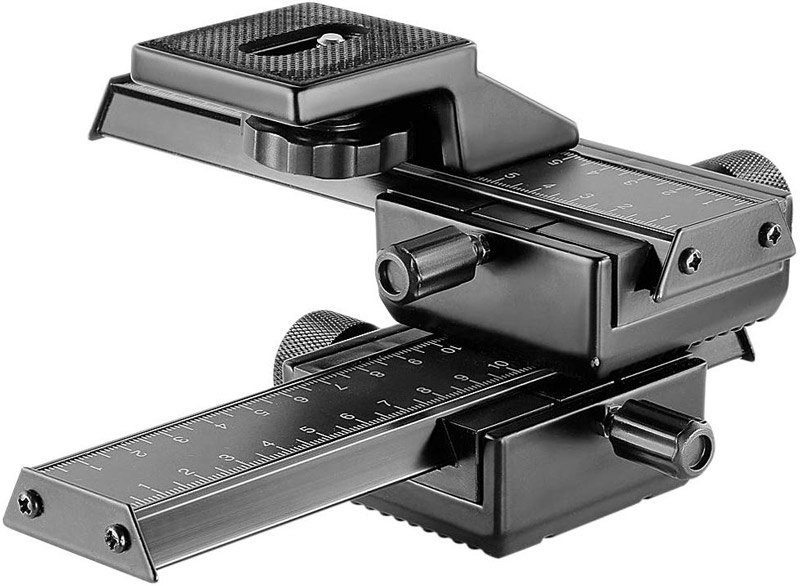
Integral dual stage macro rails
The second option are integral two stage macro sliders like the Neewer Pro 4-Way Macro Focusing Rail. They have a non-removable link between the X and Y stage carriges, and cannot be dismantled into single stage units. The advantages of this model are lower price (compared to the purchase of two single stage rails) and a nominally easier setup. Disadvantages stem from the inability to dismount the two stages, resulting in increased height that can get in the way in certain setups.

